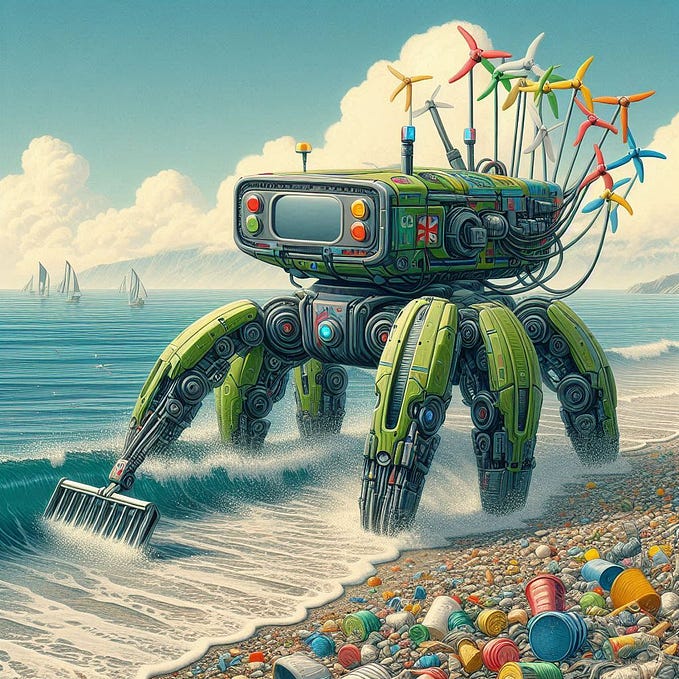“Computer as Furoshiki” (1993)
This is a good example of a typical off-the-wall sci-fi speculation that sits around trying to become premonitory for decades on end. Most ideas like this, and man do I have a lot of them, aren’t “premonitions” of anything. They’re just eccentric notions that wink out like flung sparks.
Maybe a hundred years later, though, something vaguely like this “daring speculation” actually shows up as some product or maybe an artwork. Then some fan of the arcane remarks, “Hey look what this dead guy said a long time ago about what just happened!” And the people who see that are like “Whoa!” For maybe five minutes.
The guys who really developed the object, product, service, whatever, who are pretty busy people by their nature and don’t have a lot of time to spare for technological whimsy, well, they might feel vaguely chagrinned. Briefly. But they get over that feeling and get back to work.
Except for one guy. He retires, or gets he fired or something, and becomes an engineering professor. He has to teach about the subject of the Whatever-It-Is, so he has to start with the first lecture with his first class.
So he tells them, “Well, strictly speaking, just from the point of academic theory, there was this notion, like, a hundred years ago. It’s mentioned in my textbook, it’s the footnote on page 22.” And the students are like, “Wow. I read my professor’s textbook. I understand technology now.”
This essay was printed in “Mondo 2000” in 1993. Later an imaginary “furoshiki” computer made a guest-appearance in my novel HOLY FIRE. Nobody ever yet built a computer made from computational fabric.
But, y’know, c’mon, maybe they would.
COMPUTER AS FUROSHIKI
by Bruce Sterling
“Computer as furoshiki” is a highly speculative vision of the personal computer as it might evolve if freed from certain current material constraints.
The furoshiki is an intimate and ubiquitous accessory to Japanese daily life. It’s nothing more than a large square of tough, well-made cloth, usually with a handsome pattern. The furoshiki is used, among other purposes, as a grocery bag, a book-tote, and a decorative wrapper for ceremonial gifts. In its simplicity and multiple uses it is little different from a cowboy’s bandanna, except that the skill in wrapping and knotting furoshikis is more arcane.
The computer-as-furoshiki is the computer as a large square of lightweight, flexible cloth. It is not, however, “cloth” as that material is currently understood.
The furoshiki’s display screen is formed by thin bands of color-emitting optical fibers, which are wide enough and bright enough to mimic the scan-lines of a video display terminal. These display-fibers are interwoven with other fiber-optics carrying data.
A second kind of fiber is densely interwoven; it consists of room-temperature superconductive wire, possibly a novel form of buckminsterfullerene for strength and flexibility. This highly-charged net of superconductors serves as a literal power-grid.
The third fiber is some currently-unknown form of piezoelectric filament that can contract, relax, and therefore warp and knot itself in response to precise electrical charges deployed along its length.
A fourth form of fiber serves as a radio antenna and communications grid.
One section of the cloth can be radically stiffened to serve as the diaphragm for an audio speaker.
Computation, memory, and movement are carried out by photonic, photoelectronic, and electronic chips composed of custom-built artificial diamond for low cost and strength. If the tensile fibers are composed of organic proteins (which would seem likely), then the computer-as-furoshiki consists mostly of carbon.
The device is operated with voice commands and touch, and possibly gesture, through a similarly woven linked glove.
The computer-as-furoshiki is capable of limited movement. Early versions might fold themselves up like a gentleman’s handkerchief; later models would resemble aluminum foil or Saran Wrap. Advanced versions can fly.
Although this computer lacks direct video input, it might be capable of optical character recognition if placed on a page, or of image-scanning if placed on a graphic.
When placed on light-sensitive paper, or film, it generates hard-copies. This computer might displace paper as a medium by usurping not merely the information of paper but the physical properties of paper as well.
When one’s head is wrapped completely in the furoshiki, it becomes a virtual-reality rig.
When not in use, the furoshiki is worn, as a scarf, tie, turban, or, or course, the Console Cowboy’s bandanna. Mainframes can be used as pup-tents, supercomputers as Big Tops, for a late twenty-first-century multimedia circus.










